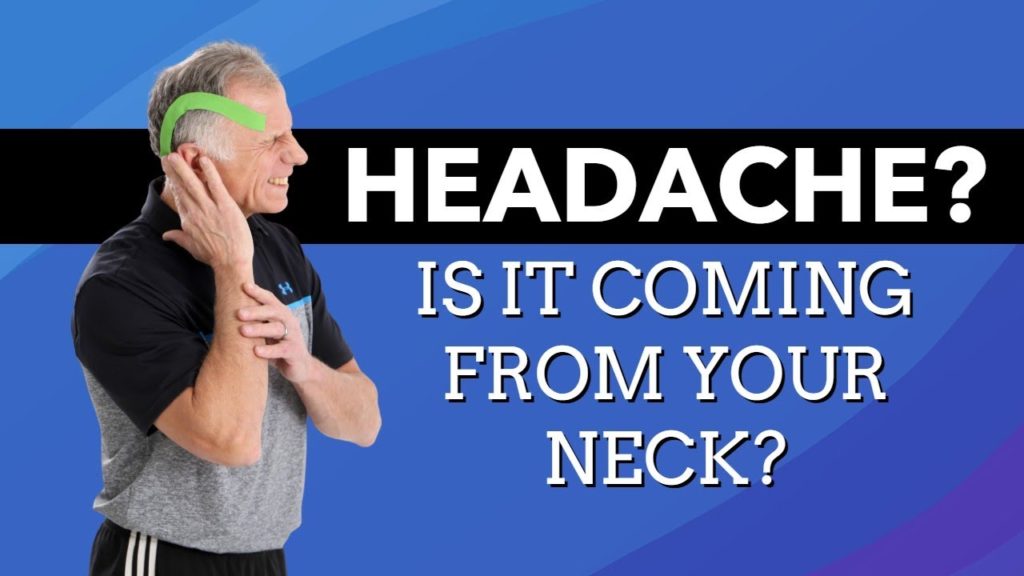i folks, I’m Bob Schrupp, Physical Therapist. – Brad Heineck, Physical Therapist. – Together we are the most famous physical therapists on the internet. – In our opinion of course, Bob. – Today we’re gonna show you two self-tests and 5 signs that your headache is actually coming from your neck.
Plus, we’re gonna show you some possible causes of why that headache. – Yep yep. One thing is it gets overlooked sometimes. – Yeah, so this is a specific type of headache, it’s coming from the neck, it’s called cervicogenic, cervico means cervical or neck. – Location – And genic mean it’s source of pain – Origin – Yeah, origin, yeah.
So, it’s caused by problems with the nerves or the bones and the muscle of the neck.
I’m not gonna get any more specific than that. – It’s upper neck. – Yeah. Quite often, yeah.
And that’s what I was gonna show them real quick Brad, here. Quite often it’s C1 and C2. So, all the bones of the neck are numbered from one to seven. And here’s number one and here’s number two. And they’re right up, yeah, up against the skull.
And that’s usually, in fact, that’s one of the signs that it could be coming from your neck, is that it spreads from the back of your head and comes around, yeah, and right there up into the eye or below the eye. – Sure. – And they call it a ram’s horn headache. – Just like the football team, if you look at the helmet. – Yeah.
– That’s kind of the pattern that it makes. – Yeah, yeah, good point.
And what did your brother-in-law call it? – Well, he would, after a car accident he would get these headaches that wrapped around and he called it, it was all around to his forehead, he called it a full wrap. – A full wrap.
– I don’t know if he made that up or his physician that he worked with or whatever, but, you know, it makes sense. It sounds right. – Yeah it sounds right. So, and it can’t be one or both sides. I see more often one side.
– Sure. – But it definitely could occur on both. The other sign is if you have a stiff neck, decreased motion, and you’re getting headaches, that’s a possibility.
– Sure – So I mean, these are all things you want to think about. If you have increased head pain or headaches when you cough or sneeze or take a deep breath, that could possibly be your neck ‚cause that’s what’s moving when you do those things.
– Right. – Yeah, and the head doesn’t always hurt if you move it. – Right. – It just hurts all the time. So, a headache that begins or is worsened by certain neck movements or postures is a good example.
So, for me, if I have a head forward posture for a long time, which I did when I used to wear my glasses.
I didn’t have the glasses made for the bifocals. – Yeah, right. – I was wearing bifocals and I had to go like this in order to see the screen and I started getting headaches. So I got glasses made just for reading a computer.
– Right, so that you can sit with proper posture. – You can sit with proper posture, right. Pain that’s felt at the top of the neck, or at the base and the lower part of the skull there. Yep, especially if it goes up into the head, that’s a good sign that it’s actually from the cervical spine. – Sure.
– Sorry, neck. Cervicogenic headaches can also cause symptoms like migraines. I never knew this, Brad. So, I always assumed when people said I have light sensitivity or noise sensitivity, oh, you’ve got a migraine. – Sure.
– But it’s not always the case. And even blurry vision can be caused by a cervicogenic headache. – Sure. – So, you wanna keep that in mind. So we’ve got two just self-tests here.
First one is, sometimes what you’ll find on people is you have them do a chin tuck and you have them rotate one direction, and then rotate, the other direction. Now you could set up your camera on your phone and film yourself doing this. – Sure. – Or you could have a friend looking at you. But what you wanna see is if one’s kind of restricted, or greatly restricted, and that’s the side you’re having headaches on, the pain on, it’s possible that that restriction is causing the pain.
– Sure, just a tight muscle that is limiting that motion is associated directly with that headache. – Yeah, and so, we’ll actually show you in one of the subsequent videos that, how to treat that. – You can treat it self-treat it. – Yeah self-treat it, yeah. – It’s not that difficult.
– The other thing you could do is actually the second self-test you could do is you start palpating or pressing along the upper neck. Yeah, right in the suboccipital area there. ‚Cause that’s, you know, often I find tenderness right here, Brad, right over that greater occipital nerve where it comes out. – Sure. – Yeah, the other possibility is sometimes you can get pain if your shoulder blades are out of whack a little bit.
Let’s say they’re descended too far. Not uncommon at all, especially if you use a mouse with one arm continually and it stretches out the muscles, and that stretches the levator scapulae. – Oh, yeah. We’ll get Sam out so you can. That’s quite a name, the levator scapulae.
I used to call it the levator scapulator. But that’s not correct. This levator scapulae from the top, It’s a small muscle.
– Yeah, here’s the shoulder blade. – Yep, and it connects from here and actually down to the lower cervical, the upper cervical vertebra.
And it is a small muscle like this. And it’s not very thick. But it can knot up a little bit. Or, if the scapulae is de-centered or..
.. – Rotated. – Rotated, makes that muscle tight. It can irritate it and cause that pain.
– And it’ll send pain right up into your head even. And the thing about this, so you can find your shoulder blade. If you’re able to reach back there you can stick it out like that. But on the inside of it and follow your hand up and you should be able to palpate along there. You probably would do it this way, wouldn’t you, Brad?
– I mean, you could start here and work down possibly. My shoulder flexibility, it’s best if you can get someone else to do this. – Yeah, that, you’re correct, Brad. You’re absolutely correct. And if you find real tender spots along that muscle you’re gonna wanna do some, watch some of our other videos, and do exercises that get the shoulder blades to rise up, or get in the right position.
But even more key is probably stopping it from happening in the first place. So, you know, if you’re using a mouse make sure that your shoulder is, you know, your elbows up. Yeah, Not out like this. You don’t wanna wear a, you know, a suitcase or a bag. You wanna switch it back and forth so that you’re not stretching one side out.
– The strap coming over. So you can get this through the series that, Bob, go ahead, you do this. – This video is part of a series of videos on neck pain. So you go to the program section, well go to bobandbrad.com.
Go to the programs section and you’ll find some on neck pain. And you just go through, it will be like 30, 40 videos. We’re still uploading them so it could be awhile. But you can pick out the ones that pertain to you. And, if you’re having trouble with your shoulder blades you can look up to that one.
– Right, so all these things we mentioned about stretches and the shoulder blade exercises, they’re in the series. – Yes. – You can just look at the title, click on it, about a 10 minute video. And there’s also the great benefit of a PDF printout. You can put the exercises on paper, preview of the video, and then you have there in front of you all the time.
– I think maybe Gumby was causing the pain here. – Well, that may be a possibility. Bob. – But, I was also gonna mention some ladies who are maybe a little more ample chested..
.. – They’re endowed. – They’re endowed. – That’s what my PT teacher described it as.
– One thing is that they wear a bra that goes way outside like this, that puts stress on their shoulders all the time, on the shoulder blade. They should get bras that actually, I don’t know what that is, they go right up against the neck I guess.
– It might be like a sports bra, too, has a wider strap that doesn’t carry over to the extreme on the shoulder. – Yeah. All right.
We’ll let you ladies figure that one out. – We don’t know what we’re talking about. – So thanks everybody for watching. (upbeat music).
Read More: What causes headaches? – Dan Kwartler

